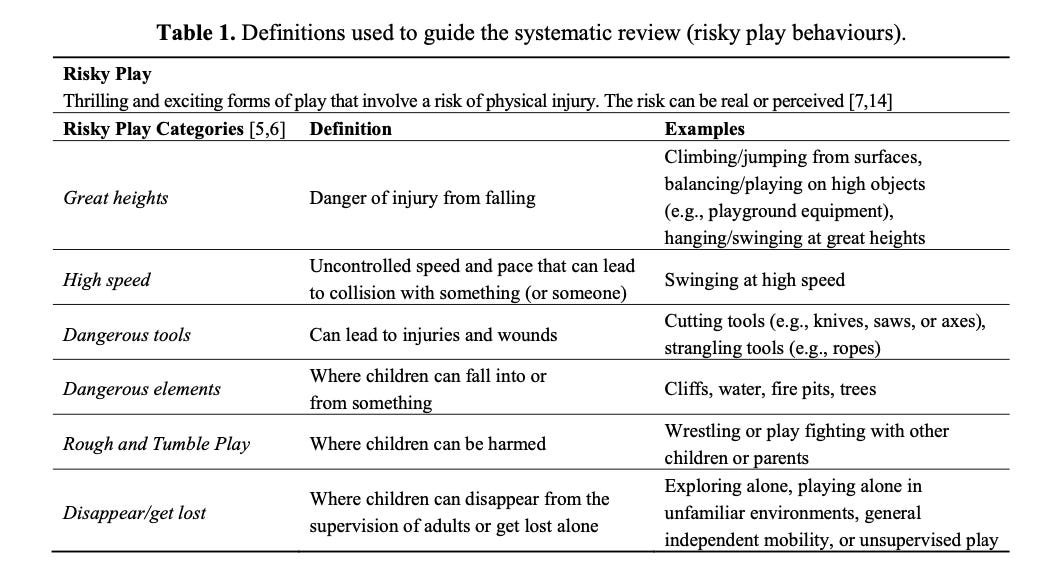Risky Play: Are You Always Saying "Be Careful"?
Research finds that risky play may actually be important for child development
Audio Version of this Newsletter:
Summer means more time outdoors for many kids and more time outdoors often means more situations that make parents nervous. This kind of play that makes us as parents feel like we might have a heart attack is called “risky play” in the research. So does research find any benefits of risky play? And, if so, how do you handle it as a parent and how do you teach your child to understand their own limits?
Source: Unsplash/Annie Spratt
Risky play in the research is defined as any type of thrilling free play that involves one or more the following: high speed, heights, dangerous tools, being near dangerous elements (fire, water), rough and tumble play, or play where there is a chance of getting lost or being unsupervised by adults (see below for examples).
Source: Brussonni et al., 2015
Risky play is observed in children as young as 1 to 3 years and children clearly show a natural and strong desire to engage in risky play. In fact, one study found that 74% of children prefer to play on more challenging and “risky” playground equipment. Yet, as parents it is our job to keep our children safe, so should we allow our children to take risks in play or should we keep them safe at all costs?
The Benefits of Risky Play
Although it might make us nervous, risky play is important for a child’s development. Specifically, risky play helps children to understand their physical limitations, develop perceptual-motor abilities, and understand how to estimate and manage risk. Decades of neuroscience research shows that learning is enhanced in situations that are risky and/or rewarding and research on play shows that play involving physical activity (which is often the case for risky play) is beneficial to children. There is also emerging research emphasizing the harms of overparenting children, which means being overly protective and removing any possible dangers from a child’s environment.
A review article of the research on risky play also found that risky play is associated with increased physical activity, as well as improved social and emotional development. Another study found that an intervention which altered playground equipment to increase risky play resulted in improved mental health for children, increased physical activity, and enhanced social-emotional skills in children.
However, it is important to note that more research is needed on this topic as most research studies on risky play specifically are rated as being “low quality”. Further research is definitely needed on this topic.
How To Encourage Risky Play (While Keeping Your Child Relatively Safe)
Allow your child to direct the play. Do not interrupt them or guide their play, unless it is necessary or unavoidable.
When you feel nervous, ask yourself if your child is really at risk or if it is more related to your own anxiety or fears that another parent might judge you.
Rather than saying “Be careful,” inform your child of the risks without judgement and allow them to decide if they feel safe (within reason). If necessary, ask them “Does that feel safe to your body?”
Create opportunities for your child to engage in nature-based risky play, such as climbing trees, playing in streams, or playing on playgrounds that incorporate natural materials. Research finds that this type of type of play may enhance creativity, imagination, and pretend play.
Use your own judgement as a parent about what is safe for you child. Intervene when you feel like the risks outweigh the benefits. For example, you may decide that the benefits of climbing on a high playground or playing with sticks are worth the potential risks, while playing on old playgrounds with sharp edges are not.
As your child gets older, gradually provide less guidance and supervision during risky play. Remember that the level of guidance and supervision you provide should be based on your child’s individual needs, maturity, and physical development.
Examples of Risky Play That You May Want to Encourage
Allowing your child to cut with “kid-safe” knives
Playing outside alone in your backyard (using your judgement about any potential risks such as a busy road nearby)
Going down a steep slide or swinging high at the playground
Climbing on large rocks and some trees
Wrestling with other children
Jumping into the pool or going off the diving board
Wondering how you can support Parenting Translator’s mission and/or express your gratitude for this service? It’s easy! All you have to do is share my newsletter with your friends and/or on your social media!
Thanks for reading the Parenting Translator newsletter! Subscribe for free to receive future newsletters and support my work.
Also please let me know any feedback you have or ideas for future newsletters!
Welcome to the Parenting Translator newsletter! I am Dr. Cara Goodwin, a licensed psychologist with a PhD in child psychology and mother to three children (currently an almost-2-year-old, 4-year-old, and 6-year-old). I specialize in taking all of the research that is out there related to parenting and child development and turning it into information that is accurate, relevant, and useful for parents! I recently turned these efforts into a non-profit organization since I believe that all parents deserve access to unbiased and free information. This means that I am only here to help YOU as a parent so please send along any feedback, topic suggestions, or questions that you have! You can also find me on Instagram @parentingtranslator, on TikTok @parentingtranslator, and my website (www.parentingtranslator.com).
DISCLAIMER: The information and advice in this newsletter is for educational purposes only and is not intended or implied to be a substitute for professional medical, mental health, legal, or other professions. Call your medical, mental health professional, or 911 for all emergencies. Dr. Cara Goodwin is not liable for any advice or information provided in this newsletter.





